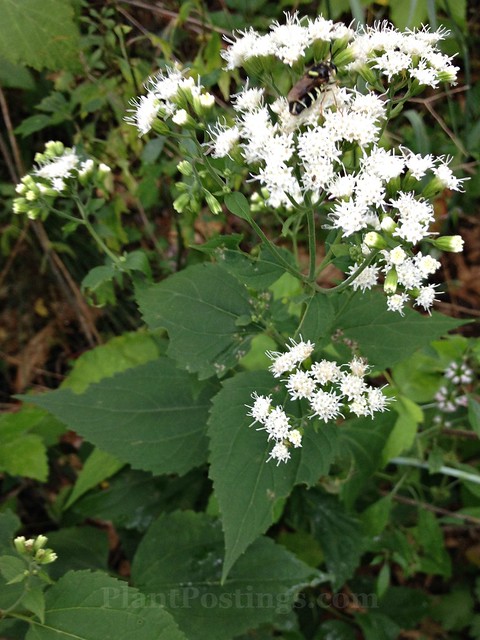
I doubt I'd ever plant White Snakeroot (Ageratina altissima) on purpose. Never say never, of course, but this one is deadly poisonous for most mammals, including humans. White Snakeroot--also known as Richweed, Tall Boneset, and White Sanicle--is blamed for the death of Abraham Lincoln's mother, after she drank the milk from a cow that had consumed a toxic amount of this plant. The poisonous compound it contains is tremetol, according to the University of Illinois at Urbana-Champaign.
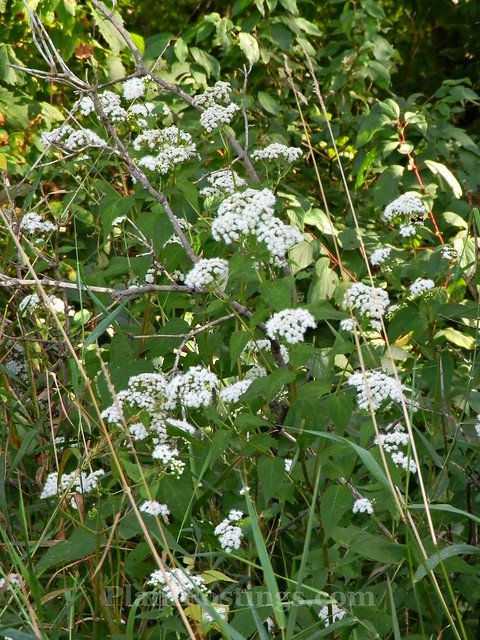
I've noticed plenty of White Snakeroot this growing season--on hikes, on roadsides, and in the open edges of woods on our property. Just as I wouldn't plant it intentionally, I wouldn't pull it either, because it's a valuable source of nectar for many bees and other pollinators--in late fall, when most other flowers have faded.
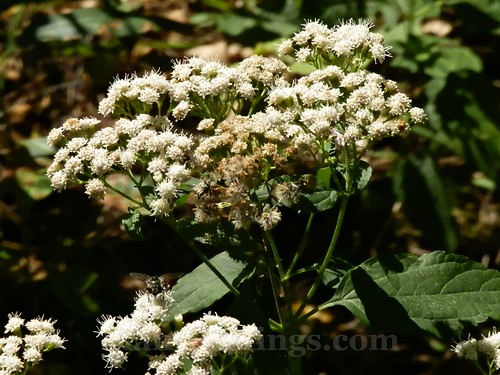
Every photo I've taken of White Snakeroot includes pollinators--big, small, and everything in between. The Xerces Society labels it a plant that supports biological control, which means it attracts predatory or parasitoid insects that help keep pest insects in check. The round heads of the plant's white flowers are arranged in clusters--giving pollinators easy access.
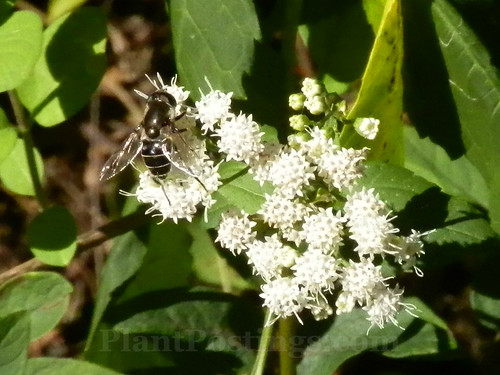
White Snakeroot is native to most of the eastern U.S. and Canada, according to the Lady Bird Johnson Wildflower Center. It grows in moist or dry soil, and has a high tolerance for drought. It prefers sun or part shade, at the edges of woods or thickets. A perennial, it grows 1-3 ft. tall.
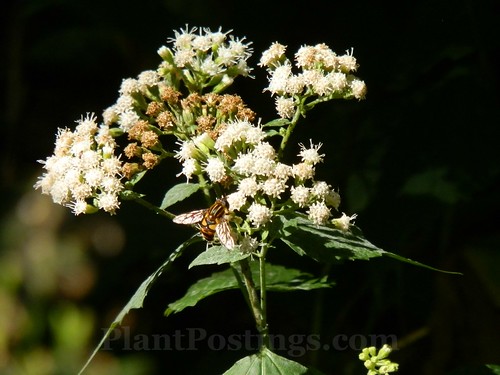
I'll be curious to hear your thoughts about this plant. It seemed like a natural to highlight for Wildflower Wednesday because it's a native wildflower and is beneficial to pollinators. I know other garden bloggers have posted about it in the past, and the reviews have been mixed.
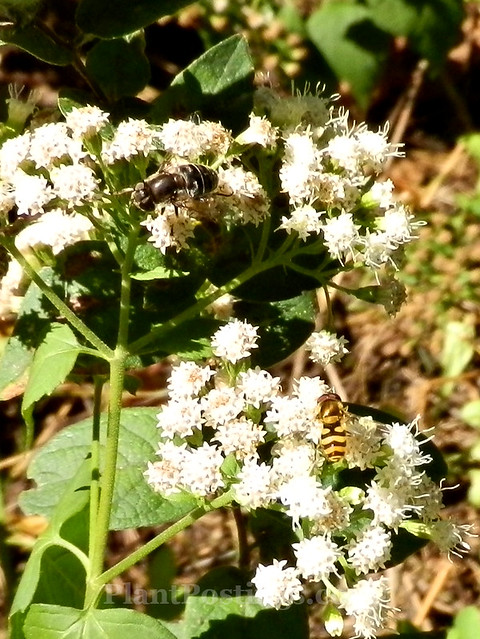
Here in Southern Wisconsin, White Snakeroot is keeping good company with other late-blooming native wildflowers, including the Goldenrods and Asters. I have to admit the flowers are pretty. I still wouldn't plant it intentionally ... but I wouldn't remove it either.
Thanks to Gail at Clay and Limestone for hosting Wildflower Wednesday!
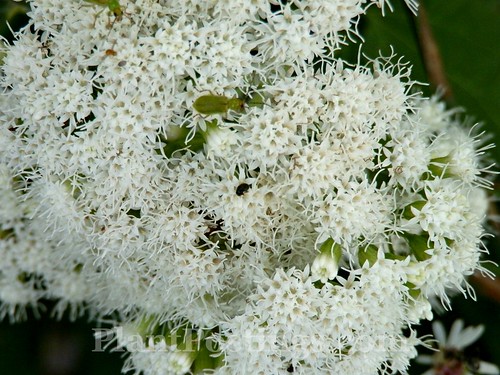
I need to look to see if I have some of that. I do have some white blooms that are similar, but don't remember if the leaves are the same. I like the blooms, too, and love your photos with the insects! I recognized some flies that mimic bees. I posted some photos in BugGuide just now, and one of the flies is the same kind as one of those you have pictured here. Thank you for the information about the plant. I didn't know it is poisonous. I wonder how many of the plants I grow are.
ReplyDeleteThe blooms of Common Boneset (Eupatorium perfoliatum) are very similar, but the leaves are thinner and they come together in the middle. The buds of the two plants look slightly different, too. Thanks for the great photos of the pollinators on your plants. I know what you mean--I don't think we realize how many plants in our gardens, right in our backyards, are poisonous.
DeleteGood information, it's good to know if a plant is poisonous. I'm growing Eupatorium altissimum, which also has similar whilte flowers but long narrow leaves. That is if it makes it through its first winter.
ReplyDeleteYes, good to know it's poisonous. Eupatorium altissimum is pretty, too. It looks like the leaves and buds are more similar to Common Boneset, which makes sense since they're both Eupatoriums. I hope it makes it through the winter for you--hopefully this winter won't be quite as horrid as the last one!
DeleteI know this plant as Boneset. We have some growing in our garden as a volunteer. When it is happy it spreads and I'm all about supporting the insect populations so it is staying. Great info Beth!
ReplyDeleteThere is a plant--Common Boneset (Eupatorium perfoliatum)--that looks very similar when in bloom, but the leaves are thinner. (Karin: You probably already know this--I'm just adding it here in case it comes up for someone else.) I don't think it's as poisonous as White Snakeroot. But both plants are favored by pollinators. :)
DeleteI love to see this plant in natural settings. White is such a clear beacon in the landscape. Would I plant it? Probably not but I do enjoy it.
ReplyDeleteYes, when in bloom it's very bright and pretty as other flowers fade. I totally agree regarding planting vs. appreciating it in its natural setting. :)
DeleteInteresting! I have a lot of the related Boneset and Joe-pye Weed growing around, but I don't think I've seen this one before. I'll have to keep an eye on it! I certainly wouldn't mind it growing around for the pollinators, but I'm sure farmers would think differently!
ReplyDeleteBoneset and Joe Pye are common around here, too, but they seem to bloom and fade little earlier. Yes, I'm sure the farmers don't appreciate this one! I suppose they have to be very careful about it.
DeleteI probably wouldn't plant this either, with three curious dogs around. But it sounds like a great plant in a naturalized setting where the bees and other pollinators could enjoy it. Interesting about Abraham Lincoln's mother--we drank unpasteurized milk when I was a kid, and I'm sure glad Dad's cows didn't eat any of this!
ReplyDeleteI don't know if the world was more dangerous in the 19th Century or now. But it sure is good to be able to easily look up information about plants so we know which ones be careful about. I'm glad your dad's cows didn't eat Snakeroot, too!
DeleteThat's a new plant for me, I'd not heard of it before and I'm fairly sure I've never seen it here in the UK. Isn't it amazing how many plants are poisonous or can provide us with benefits! I'm glad you leave it in for the insects to enjoy, it's actually very pretty.
ReplyDeleteYes, it's fascinating how many plants are hazardous and helpful at the same time and for different reasons and species. Sure makes nature complicated! It is a pretty plant when it's blooming.
DeleteI see this wild and in people's yards and never knew what it was. Thanks for the clarification.
ReplyDeleteIt seems to be plentiful this year. I always have to look closely to ID it--so many white-blooming plants with small fuzzy flower heads. But this one seems to be among the latest-blooming and has bigger, serrated leaves.
DeleteIt kind reminds me of Wild Quinine. Similar bloom. I would probably plant it in a woodland garden.
ReplyDeleteYes, it does look a bit like Wild Quinine from a distance--but the leaves of Snakeroot are a bit wider and the flowers a bit fuzzier. It does seem to be suited to woodland habitats--away from grazing animals and pets.
DeleteWe have a similar native plant commonly known as White or Fragrant Mistflower planted in my garden. Eupatorium havanese is the botanical name and it is a beauty in bloom so I have planted it in the shade garden.
ReplyDeleteI looked that one up--it is very similar. I see that it's hardy to zone 7b. We have many Eupatoriums that are hardy here, but that one isn't apparently. I imagine it looks beautiful in your shade garden, Shirley.
DeleteWhat an interesting post. I' he never heard of this plant before. It is very attractive. It must be extremely poisonous if drinking milk from a cow that ate it would poison you. I wonder what happened to the cow.
ReplyDeleteIt is pretty in full bloom, and the pollinators do enjoy it. Apparently mammals of all types can get quite sick or die from the toxin--the University of Illinois link above describes it in good detail.
DeleteI love seeing it along wooded paths, but I don't think I would ever plant it intentionally, either.
ReplyDeleteYep. It's worth appreciating for its pollinator value and beauty, but not one I would intentionally plant in my garden.
DeleteThat is really good information. I will have to be on the lookout to see if Snakeroot grows here....it would surprise me if it didn't. you took some really beautiful pictures....it's a very pretty flower!
ReplyDeleteThanks! I was amazed at the number and diversity of pollinators on it. Not much else was blooming up at the cottage recently, so it's good we have a couple of healthy patches up there. These photos were taken in various locations around the southern part of the state, though.
DeleteA new one on me, but a very interesting read Beth. It's great to have something around this late for the pollinators
ReplyDeleteThanks, Angie. Yes, they did seem to go for the Snakeroot. So many other wildflowers are done, so it's good to have several options for the pollinators. It kind of illustrates how annuals can be helpful for them late in the season, too. My Zinnias, Marigolds, Cosmos, and Lantanas are still going strong.
DeleteBeautiful photos! I have a related plant, Ageratina havanensis, commonly called Shrubby Bones, White Mistflower. Ours are not quite in bloom yet, but are also excellent for pollinators.
ReplyDeleteThanks! Shirley was mentioning that plant, too. It's not hardy here, but it sounds like it fills a similar niche for the pollinators. ;0
DeleteWow, I had no idea it was poisonous ~ I have a nice clump growing in my garden. Wait, mine is actually 'Chocolate snakeroot' (Eupatorium rugosum) Wonder if it has the same properties? It's in full bloom right now & the bees are enjoying it.
ReplyDeleteI believe Eupatorium rugosum is the previous name before it was recently reclassified as Ageratina altissima. (With all the DNA research and new names, it's hard to keep track!) My understanding is that 'Chocolate' is a White Snakeroot cultivar and that it, too, has the tremetol toxin.
DeleteI've seen this growing along trails and always wondered what it was. Good information to know!
ReplyDeleteIt seems especially plentiful this year. I know a lot of people think of it as a weed, and I kind of did, too, until I realized how important it can be to the pollinators. But, again, I wouldn't intentionally plant it in my garden. Yes, it's good to know about plants that can be harmful.
DeleteI grow Melianthus for its beautiful leaves, and the spikes of flowers which the birds love. It is poisonous, but I'm not about to eat it, so it's not a problem to me.
ReplyDeleteGood point. I feel the same way about a lot of garden plants. I guess I wouldn't want this one growing near my horses or cattle ... or dog, if I had one. But otherwise, in a woodland, wild setting it's not causing any trouble and is actually quite beneficial. :)
DeleteI always considered this an unwelcome weed, though it's good to know it attracts beneficial insects. Didn't know the Abraham Lincoln connection.
ReplyDeleteYes, it has been underappreciated by yours truly, as well. I noticed in one local location, though, that it was the only thing blooming and the pollinators were swarming it. So, while I won't plant it, I won't pull it either, unless it's taking over a formal part of the garden.
DeleteGreat macro! So beautiful! I have never noticed the petal before, Thanks for sharing.
ReplyDeleteThank you, Endah. Interesting how "weeds" have their place. The blooms on this one are pretty and beneficial to pollinators in autumn.
DeleteI can't say I have ever heard of this plant before...and now although it's a great wildflower, and valuable, I'm glad that it doesn't grow here.
ReplyDeleteGot to ask, I suppose the cow died also?
Jen
I'm not sure if it's known whether that particular cow died or not, but too much of the plant can kill cows and other mammals. They call it "milk sickness" and the animals tremble, get sick, and sometimes die. Not pleasant.
DeleteNow I'm on the hunt for white snakeroot, keeping in mind that it can be as deadly as it is charming.
ReplyDeleteI would imagine you can find it in the woods in Georgia, as well, since it sounds like it's native there, too. It's one of those plants that's fun to watch when not much else is blooming. The pollinators really swarm it!
DeleteUh oh! I have this in my garden but it might be a bit different. I don't think I have the straight species but the white mist flower whose Latin name starts with a C. I wonder if they're cousins. :( But my dogs never eat it, I don't have any cows, and the pollinators love it. Time to do some research.
ReplyDeleteI wonder if you have the Eupatorium havanense (syn. Ageratina havanensis) that Shirley mentioned? Or maybe Conoclinium greggii 'White'? I just did a little research. A lot of them have similar flowers, and even similar foliage. I think they're all in the Aster family.
DeleteI can see how it is called tall boneset as it is so similar to boneset. I have a similar plant in my garden and was wondering what it was...it might be snakeroot. I will have to check into this. Since I have no pets and the garden is fenced, I don't worry about it being poisonous.
ReplyDeleteYes, the flowers are almost exactly the same as Common Boneset (Eupatorium perfoliatum). The buds are a little different and the foliage and how it meets the stem is quite different. It's confusing. I had to look closely at some of my photos to try to figure out which ones were Boneset and which ones were Snakeroot. :)
DeleteThat's a pretty looking plant, but I can see why people with livestock or pets wouldn't be fans. I instigated some controversy last year talking about how much I liked ragwort, which is a rather pretty yellow flowering native that is apparently rather toxic for horses. Since no horses visit my garden I was happy to let it brighten the rather barren untouched area of my front garden, but lots of people think it should be pulled out on sight in case it self seeds somewhere that horses could get to.
ReplyDeleteYeah, I guess it depends on the purpose and placement of the planting. I guess I think the neighbors' dogs are mostly either walled in or under supervision--they don't tend to wander through my garden unsupervised. The Snakeroot here at home is on the edge of the woods, and at the cottage--the whole place is pretty wild. Horses don't wander in either place. So, yes, I would agree with you.
Delete